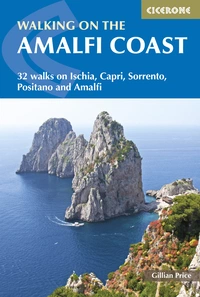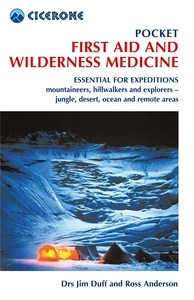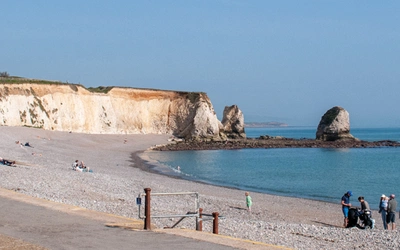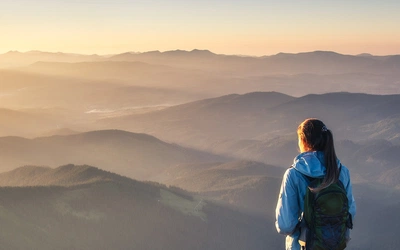Rewilding Abruzzo - bears and wolves and learning to live together
Stuart Haines explains how the natural balance of the extraordinary biodiversity in Abruzzo in central Italy has been recovered through the practice of rewilding.
There is a place that lies, unexpected and wild, at the heart of a modern industrialised country. Here the natural processes that once created the landscape still flourish and the balance of life is healthy and sustainable. People and wildlife live by the rhythms and patterns of the millennia, thriving and benefiting from their mutual dependence.
This is the region of Abruzzo in central Italy. It’s an area of high mountain chains, gorges and plateaus, deep forests and cultivated hills that roll gently to the long coastline. And of towns, motorways, factories and shopping centres. A place most certainly of and in the developed world and yet, there is a real sense of connection to the ancient ways of nature.
Much of the region is a haven for the endemic wildlife of the Apennine mountains and of Southern Europe. The ecosystem is rich in species and habitat, from the large predatory mammals and birds to the brightest and tiniest of the mountain-top flowers. There is an extraordinary biodiversity in a place, less than two hours from Rome, that has been a site of human civilisation for thousands of years.
Today the extensive natural forests and wild summits are home to wolves, lynx, chamois, red deer, boar, wildcats, pine martens and, by no means least, the Marsican brown bear. The skies above the crags and high plains are patrolled by golden eagles, griffon vultures, buzzards and peregrine falcons. Thousands of dense hectares of mountain beech, oak, black pines and firs cover the mountain slopes and spill into the valleys. Lower down, copses of poplar, hazel, willow and walnut, the rivers and ponds and the hay meadows and crop fields sustain a healthy population of roe deer, foxes, otters, hares, woodpeckers, jays, nightingales, bee eaters and all number of insects and reptiles.
Years of damage
The environment, to a great extent, is in good health but not now as robust as it once was. Don’t think it has been a straightforward journey. The totality and complexity of life in Abruzzo has been damaged over the centuries by the people who have lived there. However, in recent decades, the descendants of those people have helped remarkably in recovering the natural balance through the practices of rewilding – the deliberate yet benign actions of humankind to promote the healing and self-sustaining processes of nature.
The paradox of rewilding is that it’s not a thing people actually do. It must be the recovery and resurgence of natural processes themselves. The land rewilds itself.
But humankind can mend the systems it has broken, restore ecological relationships that were destroyed, promote their recovery and thereafter act in ways that do not impede the reassertion of nature’s order.
Sometimes rewilding sees the reintroduction of extinct native species but usually it is the preservation and encouragement of existing but threatened natural processes and wildlife. In Abruzzo this has been almost entirely the case.
Unintentional neglect of the landscape, the result of a marked depopulation of the countryside in the last century, has been an important factor in the beginnings of recovery. When left to itself, nature reverts to natural ways of doing things. But the most significant steps have come through active protection and mindful encouragement of the ecosystem to rebalance itself.
National parks and reserves, where people’s activities can be controlled and previous damage to the environment can be rolled back, are the rewilding backbone. The first to be established was the Abruzzo, Lazio and Molise National Park in 1922; an act that saved the Apennine Chamois and created a place that is now the core sanctuary in the precarious survival of the Marsican brown bear. Then came the larger Gran Sasso and Monti della Laga National Park in 1991 and, two years later, the Maiella National Park. When you add the Sirente Velino Regional Park, created in 1989, and the dozens of other nature reserves you arrive, astonishingly, at getting on for a half of Abruzzo now afforded environmental protection status and active rewilding programmes.
As a result of unchecked hunting, the numbers of the beautiful Apennine Chamois reached a critical low in the early 20th century. Only a few tens were thought still to exist, driven onto the craggy ramparts of the Marsican mountains, above the Upper Sangro valley. The subspecies however, was brought from the brink of extinction largely due to the carefully implemented protectionist measures of the new Abruzzo National Park.
Healthy population
Today, chamois thrive. They number well over 2000 and have been reintroduced to other ranges in Abruzzo – the Maiella and the Gran Sasso National Parks also now host healthy populations. They are a joy to see, the herds seemingly dancing across vertiginous cliffs or sunning themselves on ledges.
Limitation of public access has also had a significant effect. It may be inconvenient not to be able to hike in the Val di Rose in the Abruzzo National Park in July and August, but for the large family of chamois who live at the head of the valley it is hugely beneficial as they can raise their young undisturbed at this critical time.
It’s a price well worth paying to be able to see these lovely creatures close-up at all other times of the year.
The outcomes of rewilding in Abruzzo have not, so far, all been good. The Marsican brown bear, a subspecies of the European brown bear, is both the icon of the Abruzzo National Park and a critically endangered species. Numbers have continued to fall in recent decades; it is thought there are just 50 individuals alive, surviving in and on the fringes of the park. As probably only 12 or 13 of these are females of breeding age, their situation is parlous. It is certain, though, that without the continuing efforts of dedicated conservationists we would already have lost these majestic, graceful animals. Their struggle could go either way.
For bears, the larger the area of protected habitat the better. A recent initiative has been to establish ‘corridors of biodiversity’ linking isolated national parks and reserves to create a much greater space where wildlife can safely roam. The corridor created between the Abruzzo and Maiella National Parks, taking in the Monte Genzana and Alto Gizio nature reserve, is proving very beneficial with bears now moving freely between these areas. For the bear population, space is vital for survival and recovery.
The case of the Marsican bear underlines a key dimension to rewilding – community involvement, understanding and identification with the cause. Consider this – interaction with local people has led to the premature deaths of at least eight bears in the last decade. Some have been accidental, car collisions and individuals drowning in livestock watering tanks, but others not – poisonings and shootings have made depressing news.
Rewilding initiatives are creating ‘Bear Aware’ communities. Attitudes towards the creatures with which we coexist, particularly the larger ones, have tended to be fearful, antagonistic and baseless. It is crucial this ancient folklore become more positive and accurate for bears to be allowed to recover in peace. Village councils, national park authorities and conservation charities are all working hard with positive publicity, education programmes, public briefings and practical advice for local people whose activities may affect bears.
Further practical steps have been taken to ease coexistence. Electric fences are provided free of charge for smallholders to protect their vegetable plots and chicken coops. Speed awareness signs have been placed along roads that bears often cross at night. Advice notices are posted around communities in the late summer and autumn, which is when bears visit the valleys to fatten up for their winter hibernation. Compensation is paid for any losses suffered.
There is a good example of how changing attitudes have been integral to the rewilding process. The Apennine Wolf, a subspecies of the European grey wolf, was hunted almost to extinction. In 1973 there were around 100 individuals left. Persecution of this elusive predator at the head of the natural food chain was rooted deeply in folklore, compounded by the occasional but overall insignificant loss of livestock to the pack.
In 1971 the conservation movement achieved legal protection for the wolf. Today the population in Abruzzo alone is about 2000 and numbers continue to increase steadily. Old fears and myths are breaking down as the national parks and the rewilding movement build upon their efforts to enlighten people as to the true nature of these shy, magnificent creatures who play a pivotal role in the wellbeing and sustainability of the natural world. Tolerance and understanding are growing alongside the numbers of the wolf population.
Rewilding is about balance, coexistence and the sustainability of the whole system. In the past people carelessly tampered with nature in Abruzzo, threw it out of equilibrium and the consequences are with us today. The wild boar is an endemic species but numbers for hunting were boosted by the introduction of the Croatian variant. These boar are well suited to much of the Abruzzo habitat and became very effective colonisers. And, crucially, they have only one natural predator – wolves. Wolves in Abruzzo, as we know, were very nearly exterminated and boar numbers soared as a result. Today there are just too many and the problems they cause for growers are significant – crops stripped, vineyards uprooted, vegetable plots destroyed.
It is expected, though, that the rewilding principle and the increasingly successful recovery of wolf numbers will soon provide a naturally effective reduction in the boar population. The diet of the Abruzzo wolf is very largely, er, wild boar.
Nature, left to itself, will assert its own balance – don’t add, don’t take away, just undo past mistakes, encourage, protect and let things be.
Holistic approach
Rewilding is a holistic approach to our stewardship of the natural world. Where there are benefits for the native wildlife there are benefits for the native people. If nature is well, then we can be well.
In Abruzzo, timber from the forest is taken sparingly and sustainably – it has been so for hundreds of years. The habitat is kept healthy for the animals and plants that live there and the trees regrow to provide the woodcutters’ great great-grandchildren with firewood of their own. Cultivation in the fertile valleys is low intensity, much of it small scale and organic. The land is healthy and productive. A dazzling multitude of wild flowers grow on the fallow fields and alongside the lanes, where insects and small birds thrive, and the local markets stalls are heavy with fresh seasonal produce.
And a new industry is flourishing – ecotourism. The chance to see a wolf or bear in the beautiful Abruzzo wilderness is felt by many to be something of fundamental value. People want to visit and businesses are being formed to help them. Local livelihoods are being created that will endure for as long as the woodcutters’.
The greatest benefit of all? To wake in the small hours of a frozen starry night to hear a wolf howling on the edge of the forest; to stand on the summit of Serra Sparvera while six curious young golden eagles twist and float around you; to wait and watch one misty September dawn as a rutting red deer stag steps bellowing across a clearing; to gasp as a chamois and two kids skip across the precipitous face of Pizzo Cefalone; to lie laughing in your bivvi bag at midnight on Guado di Coccia as a sneaky fox makes off with your breakfast; to stare into the ancient eyes of the big boar in the bushes that didn’t notice you approach…
These are the pure and fleeting moments when your soul shivers and spirit flies to the heights. You know your place in the world and that you are in it. You know how it is to live.













